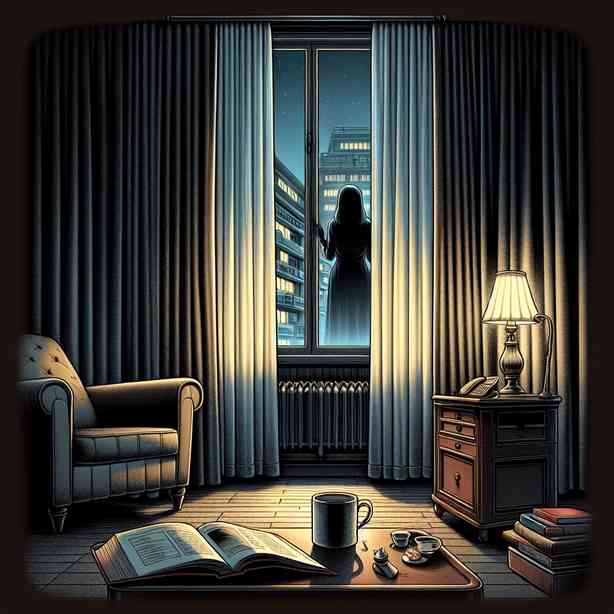
In the world of human emotions and behaviors, there exists a fascinating phenomenon that often goes unnoticed: the act of checking behind curtains. This seemingly mundane behavior can be seen in various contexts, from daily routines to thrilling narratives in movies and literature. Understanding why we check behind curtains can unveil deeper insights into human psychology, societal influences, and our innate curiosity.
To begin with, the act of checking behind curtains primarily stems from a human trait known as curiosity. Curiosity is an essential aspect of our nature, driven by the need to understand our surroundings and reduce uncertainty. For example, a child might peek behind a curtain, driven by an adventurous spirit and an eagerness to discover what lies beyond. This behavior is not limited to children; adults often check behind curtains for similar reasons. The fear of the unknown can prompt individuals to investigate areas that seem secluded or hidden.
Moreover, the act of looking behind curtains can also represent a subconscious emotional response to fear. In many cultures, curtains symbolize barriers between safety and danger, revealing the things we wish to keep hidden or protect ourselves from. This ties into the broader theme of our relationship with fear and vulnerability. Checking behind curtains allows individuals to confront their fears, even if it is a benign action. It embodies the desire to reclaim a sense of control over one’s environment, especially when uncertainty looms.
Additionally, this behavior can be rooted in storytelling and cultural narratives. For instance, throughout history, various tales have been spun around hidden spaces and what one might find behind them—a monster lurking in the dark or a treasure trove of secrets. These narratives not only amplify our curiosity but also shape our responses to similarly real-life scenarios. By checking behind curtains within our homes or workplaces, we may inadvertently connect with the archetypes and motifs portrayed in those narratives, drawing on lessons that span generations.
On a more psychological level, the act of checking behind curtains may symbolize the process of self-exploration. Curtains can be seen as metaphors for the barriers we erect in our lives—those parts of ourselves we keep hidden from others and sometimes even from ourselves. By checking behind these metaphorical curtains, we allow ourselves to engage in self-reflection, exploring our fears, desires, and motivations. This introspective act can lead to personal growth, helping individuals confront what they have long kept hidden.
In addition to psychological implications, there’s also a social aspect to the habit of checking behind curtains. Human beings are inherently social creatures influenced by their environments, relationships, and cultural backgrounds. The act of peeking behind curtains can be seen as an expression of our need for connection and understanding. It reflects our desire to engage with and decipher the complexities of our surroundings, whether that involves the people in our lives or societal dynamics at large.
As we contemplate the various dimensions of checking behind curtains, it’s essential to acknowledge the role of trust. Trust is foundational for any relationship, personal or communal. The act of looking behind curtains may symbolize a lack of trust, whether it pertains to oneself or others. It can demonstrate the instinct to verify circumstances before setting oneself completely at ease. In relationships, checking behind metaphorical curtains could signal a need for transparency; a desire to see, understand, and trust beyond what is presented.
Furthermore, the phenomenon extends beyond mere curiosity, fear, and interpersonal dynamics, delving into the realm of societal behavior. In cultures where privacy is highly valued, checking behind curtains may take on heightened significance. For instance, in instances of surveillance or uncertainty, individuals may feel compelled to look behind these veils not just as an act of curiosity but as a necessary measure for safeguarding their privacy. This behavior can reflect broader societal tensions surrounding privacy, security, and the interplay of the two in an increasingly monitored world.
Upon examining the act of checking behind curtains from various angles, including psychological, social, and cultural perspectives, one can recognize it as a multifaceted behavior. It is more than just a simple action; it encapsulates our desires for understanding, connection, and control in an unpredictable world. Each glance behind the curtain can symbolize an exploration of deeper truths, an act of introspection, or even a confrontation of fear.
As we conclude this exploration of why we check behind curtains, it is imperative to appreciate the complex interplay of curiosity, fear, trust, and societal influences that shape our behaviors. This simple act provides a profound insight into our human experience, revealing the underlying emotions and instincts that guide us. Whether it is in the comfort of our homes or within the broader context of our lives, the act of looking behind the curtain invites us to venture beyond the surface, confront our fears, and embrace the journey of self-discovery. By understanding this behavior better, we can appreciate the deeper layers of human emotion and connection that lie just beyond the never-ending curtain of life.


